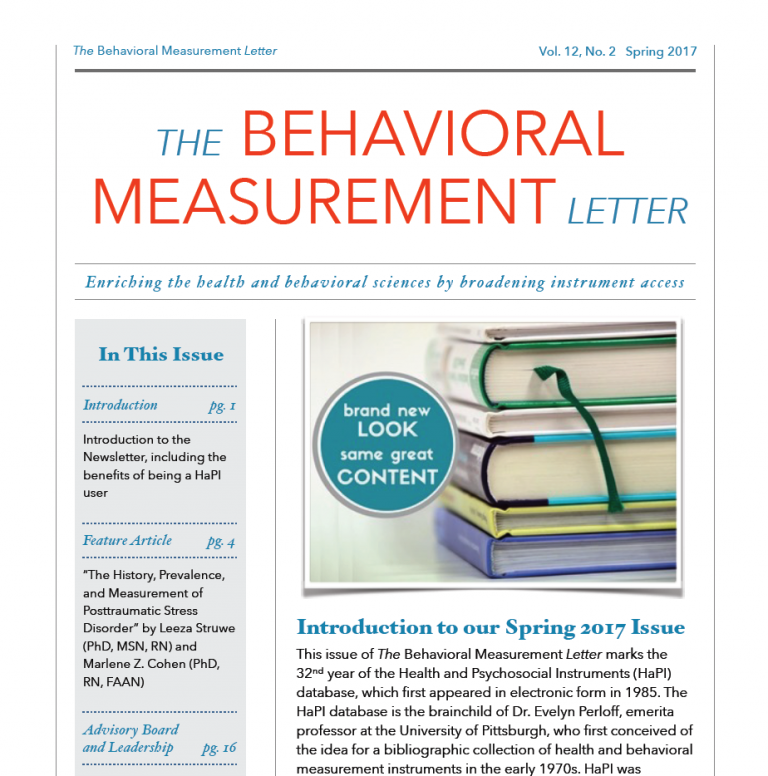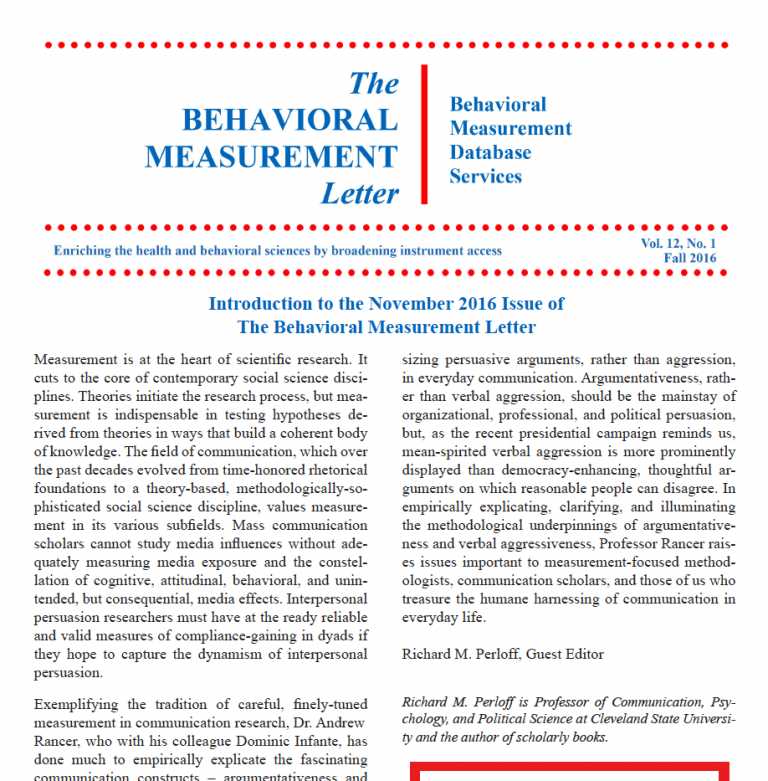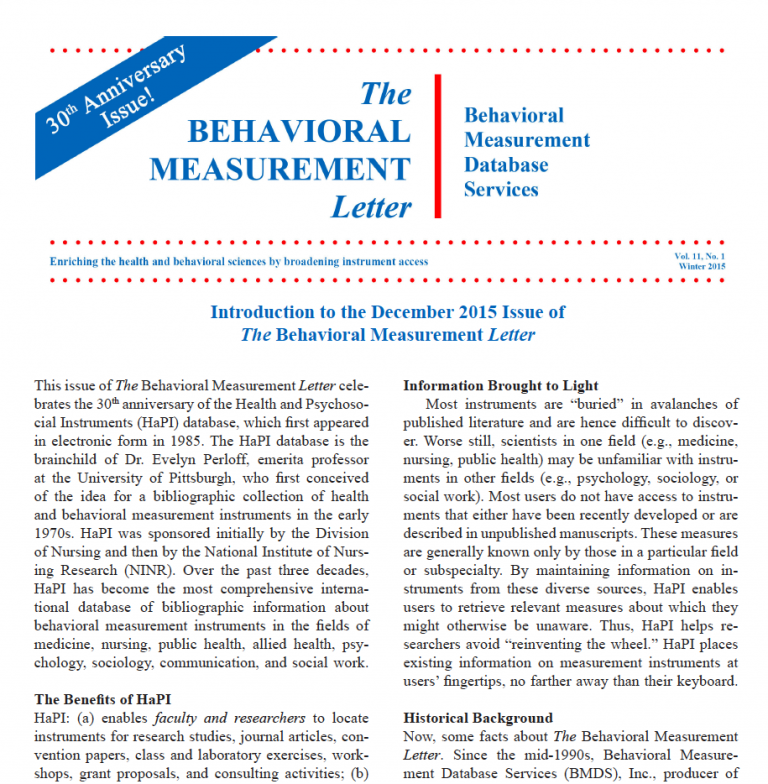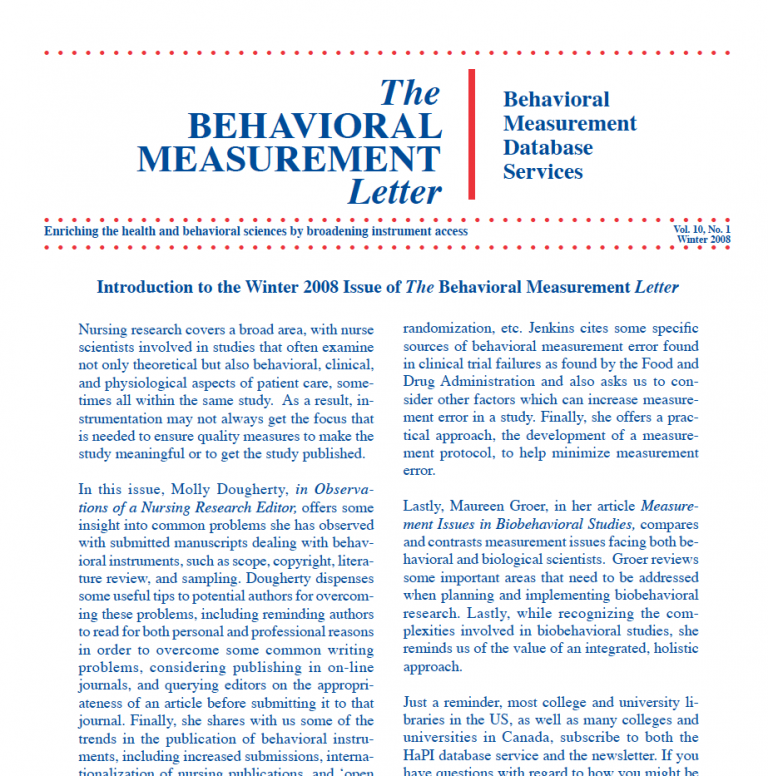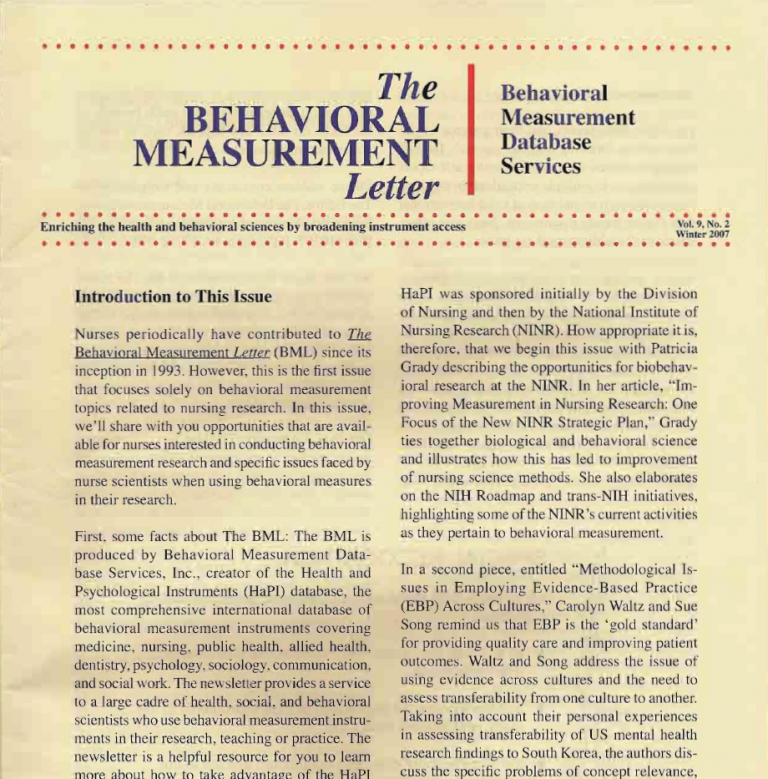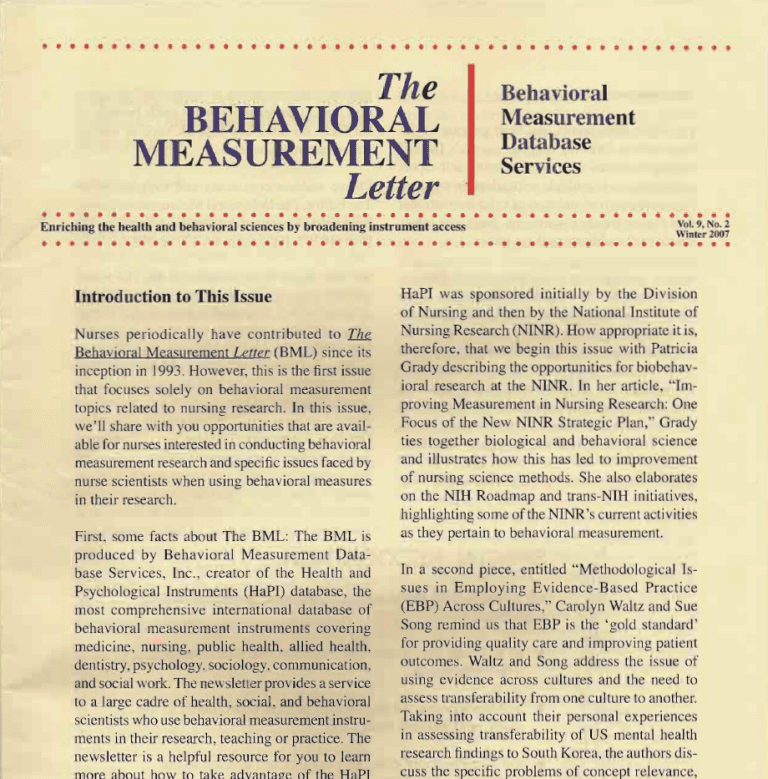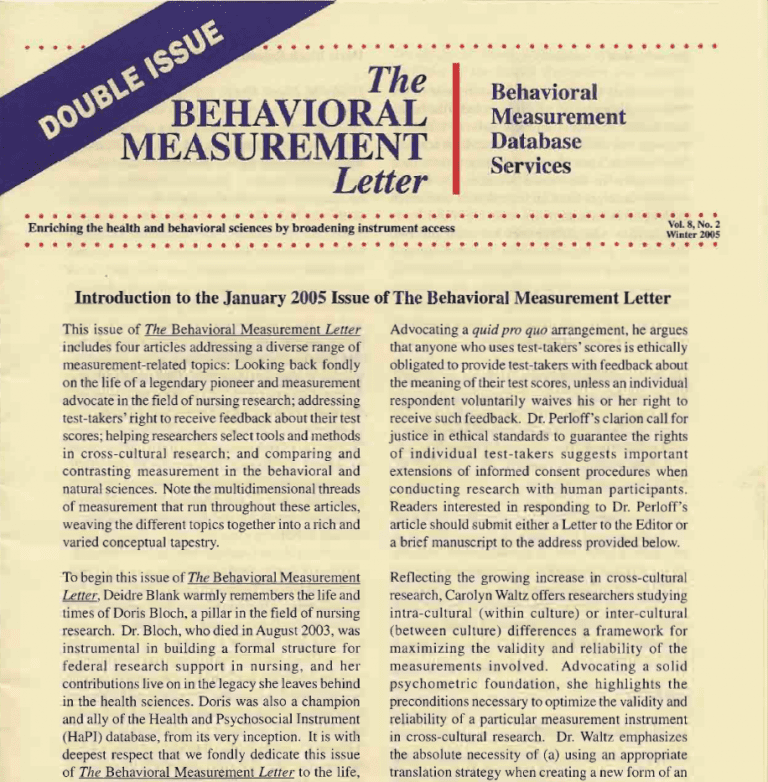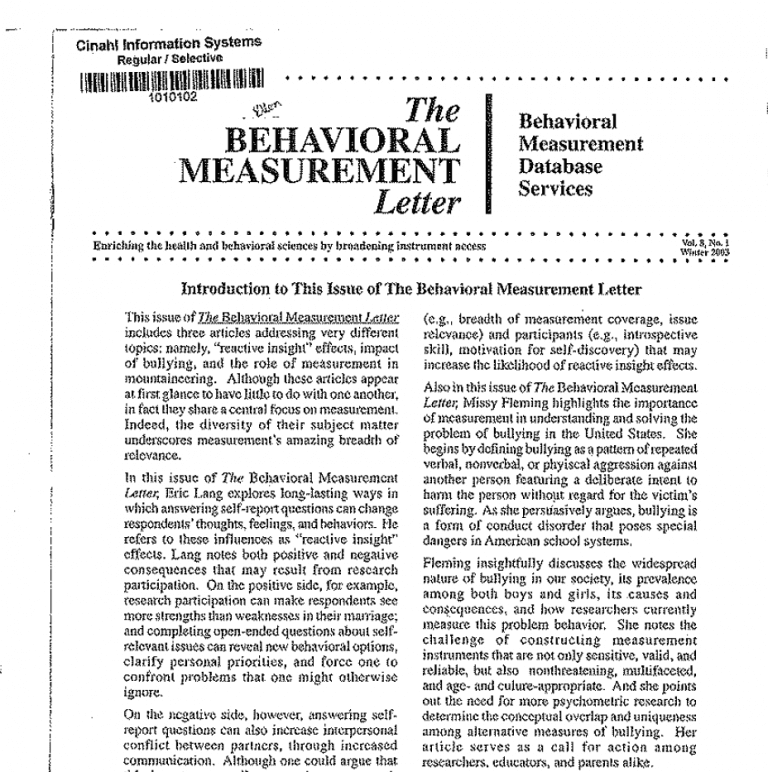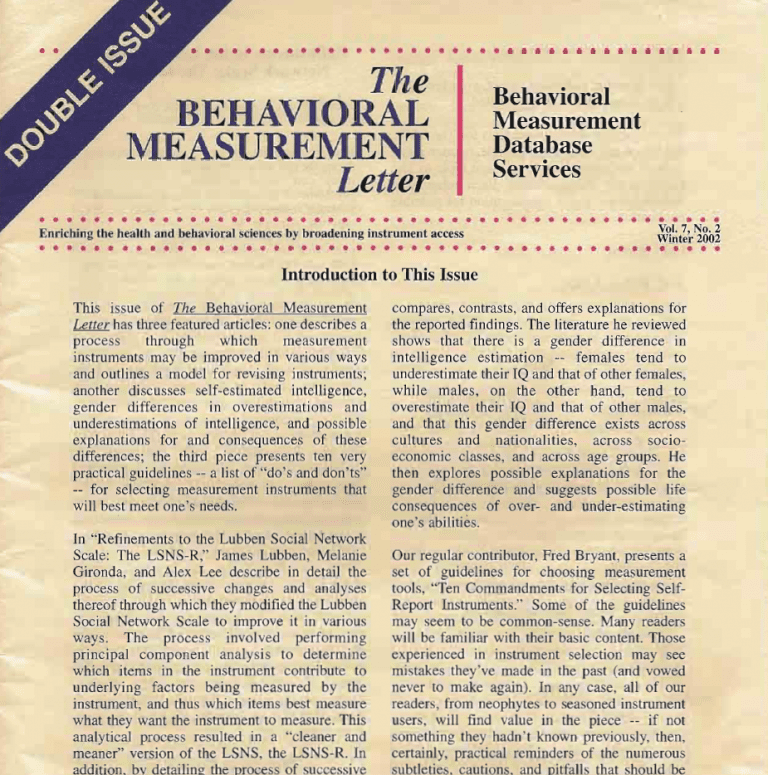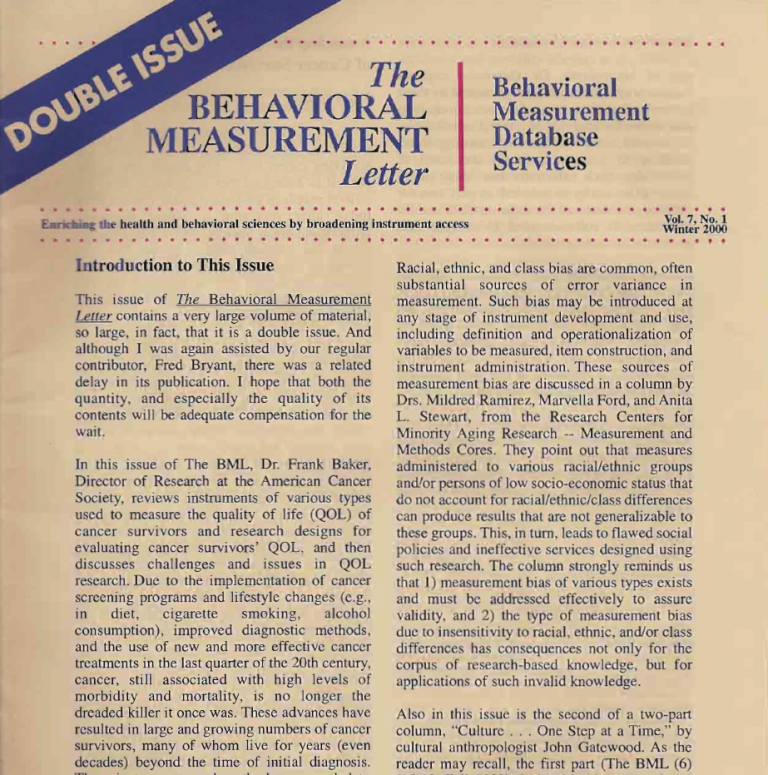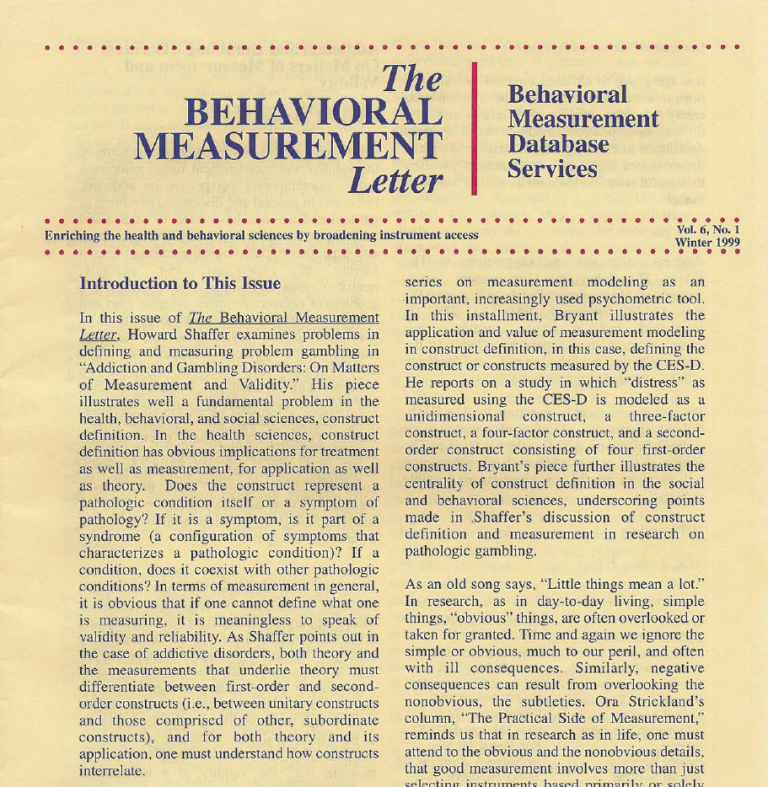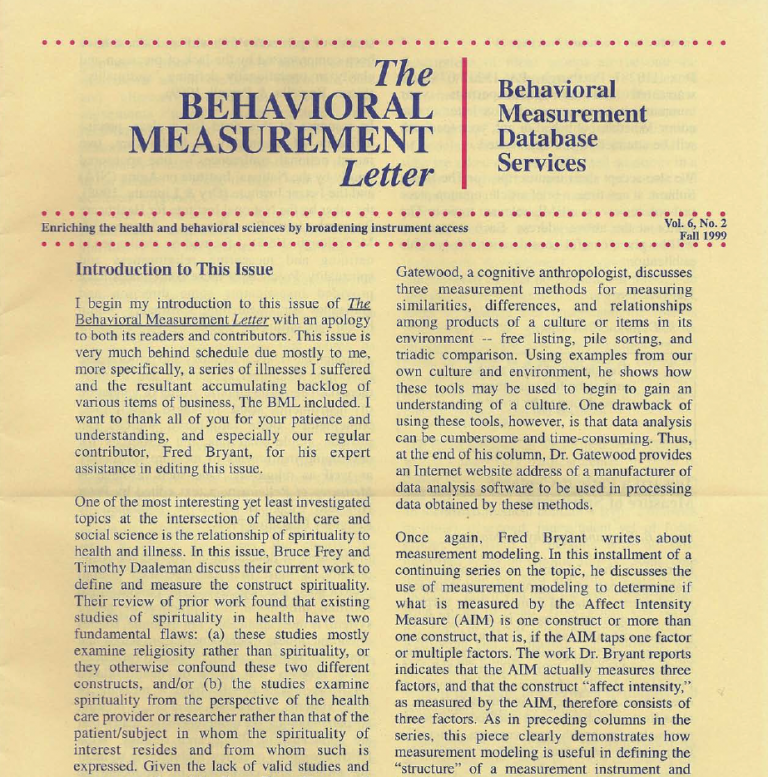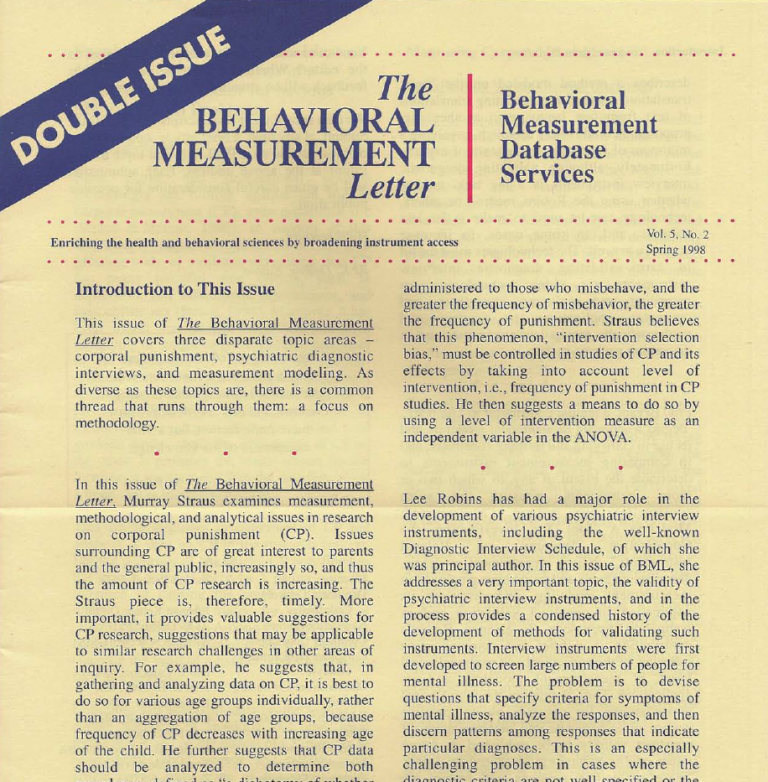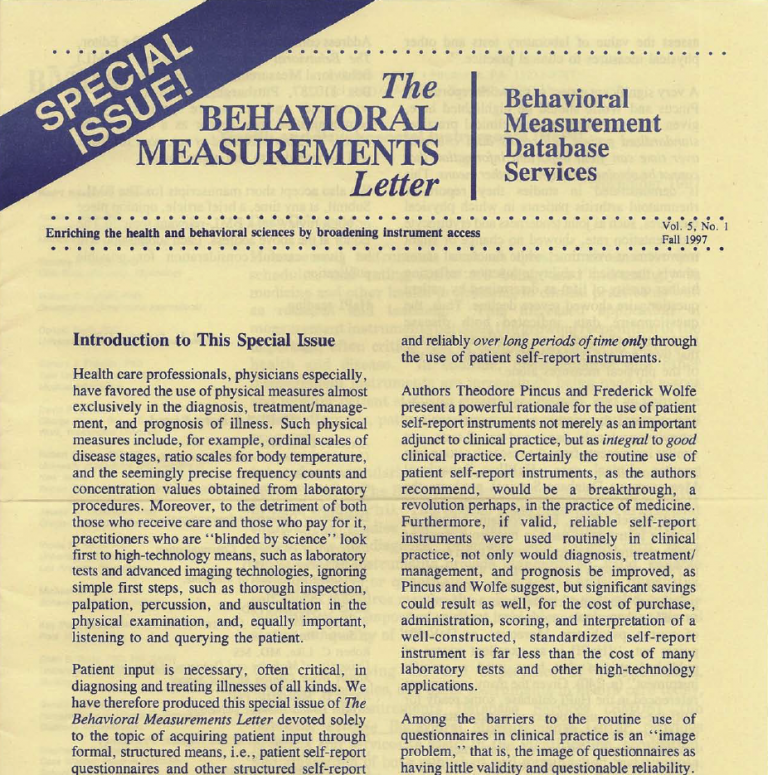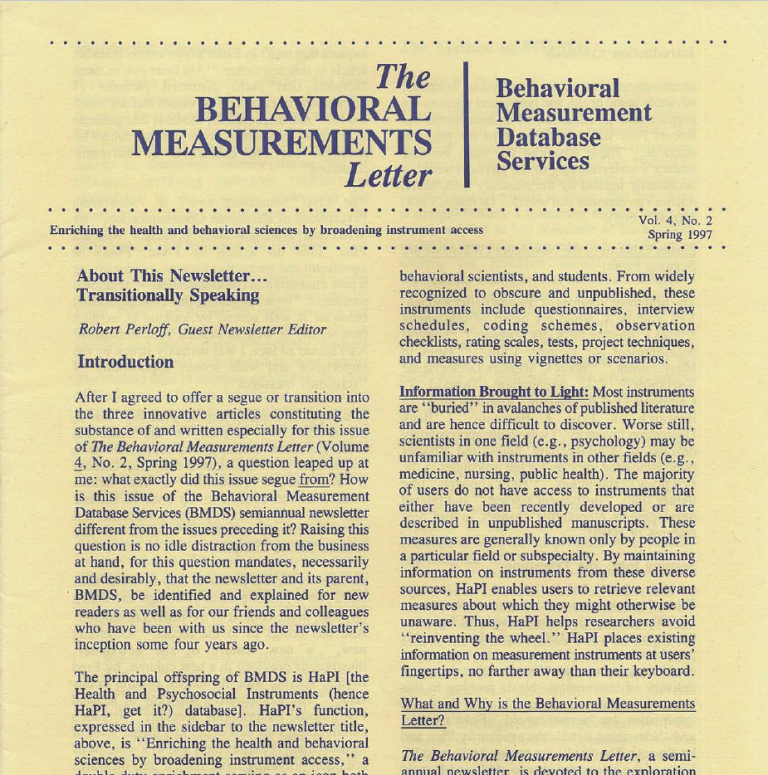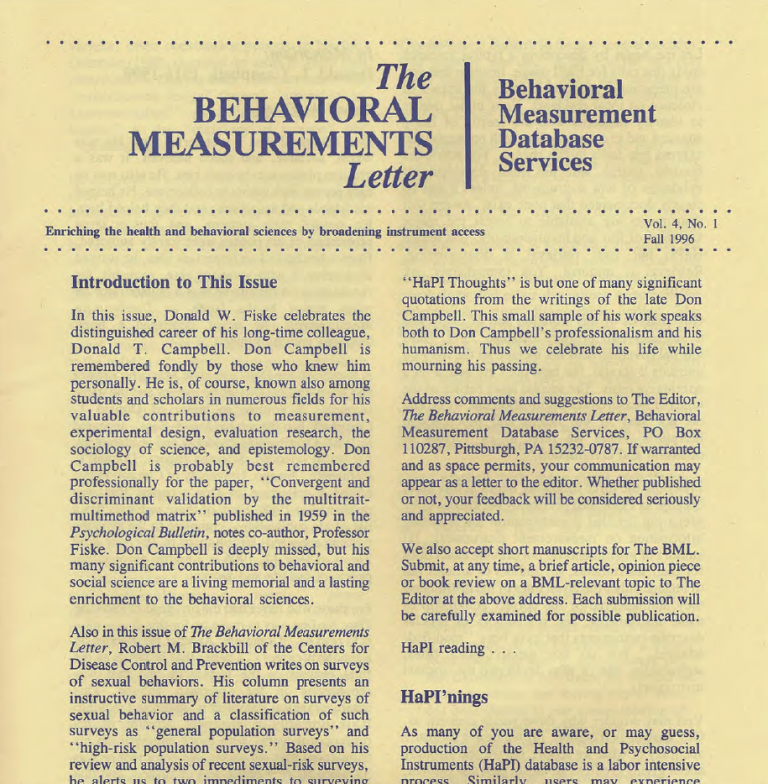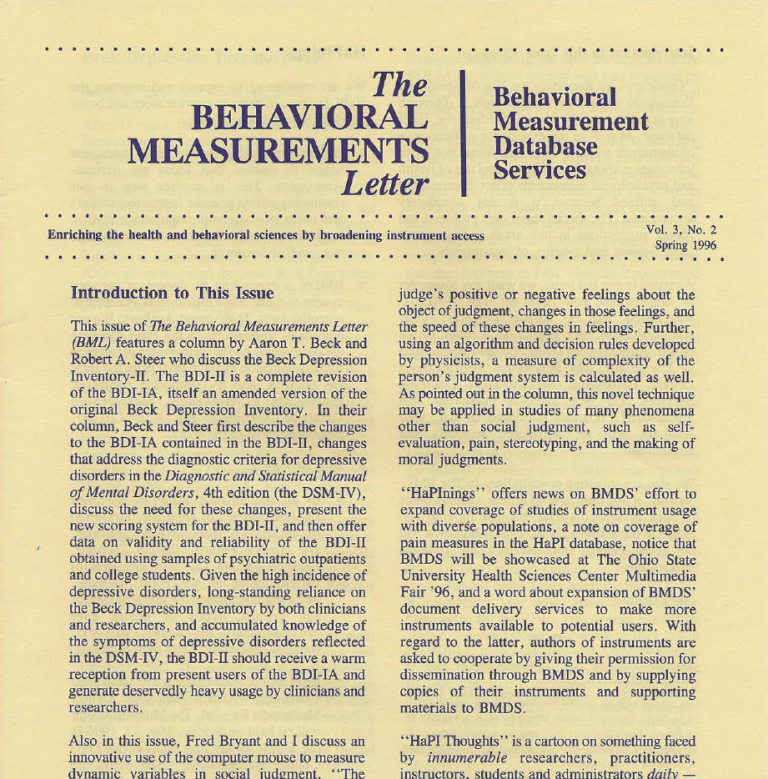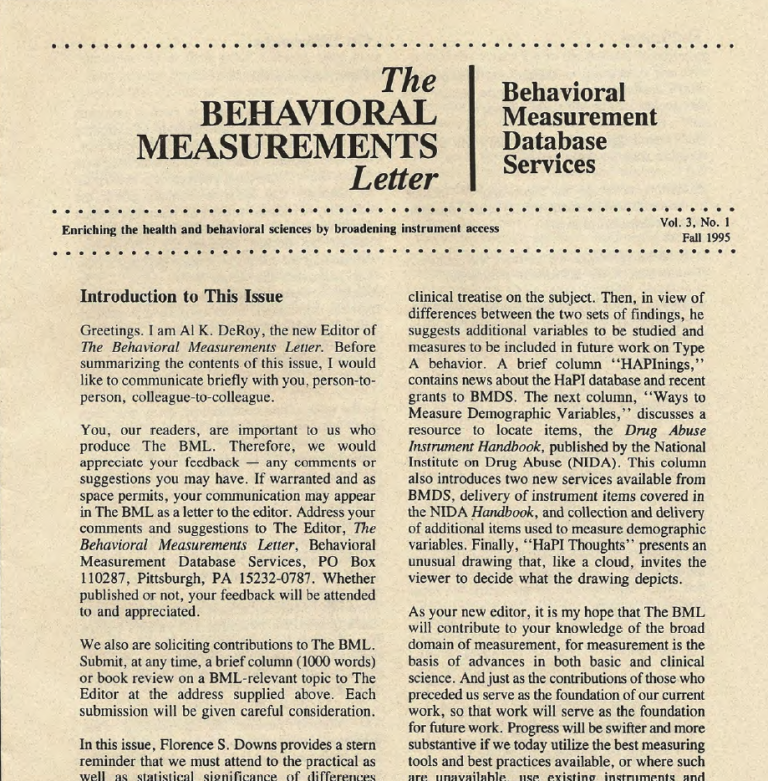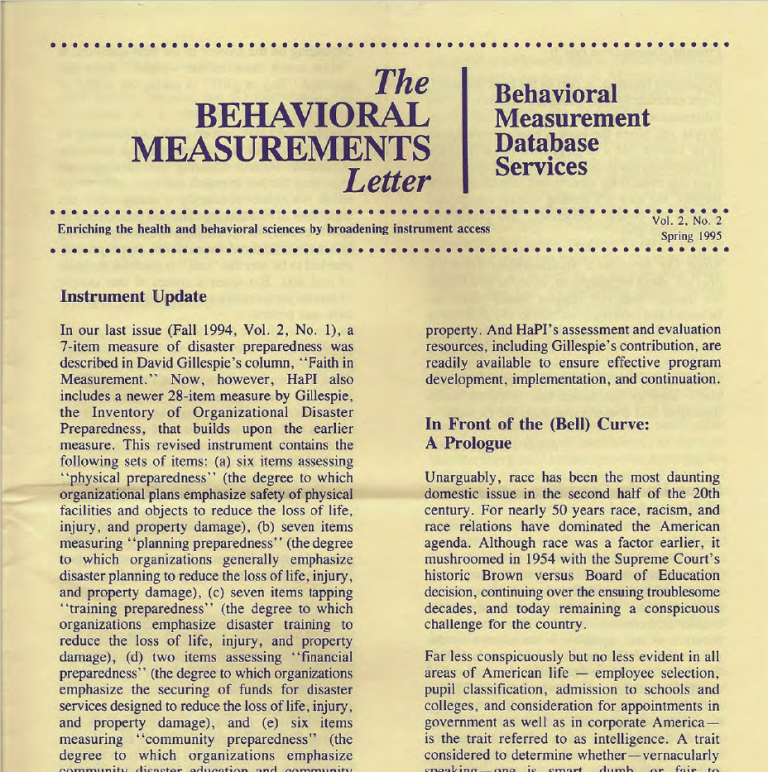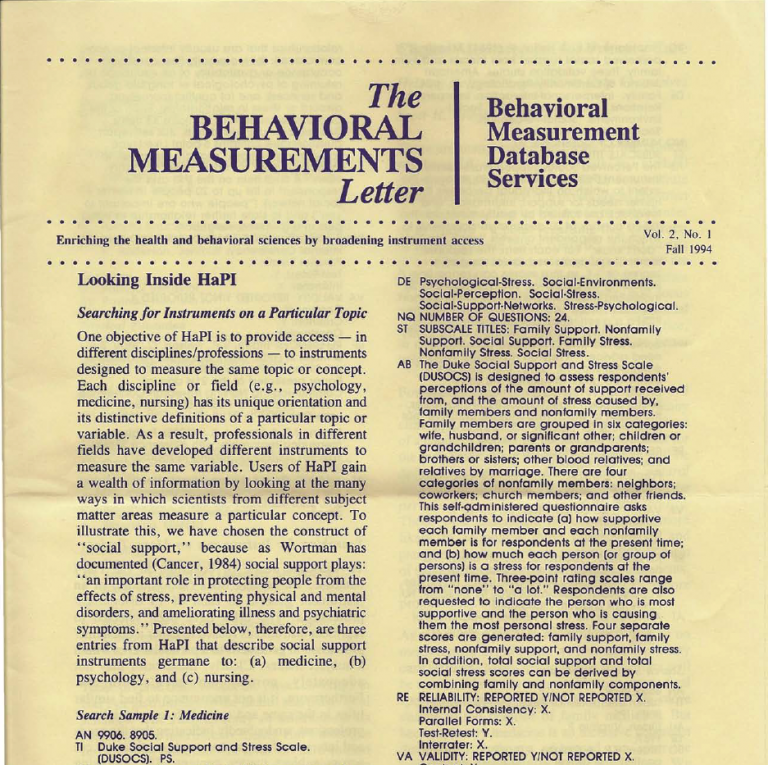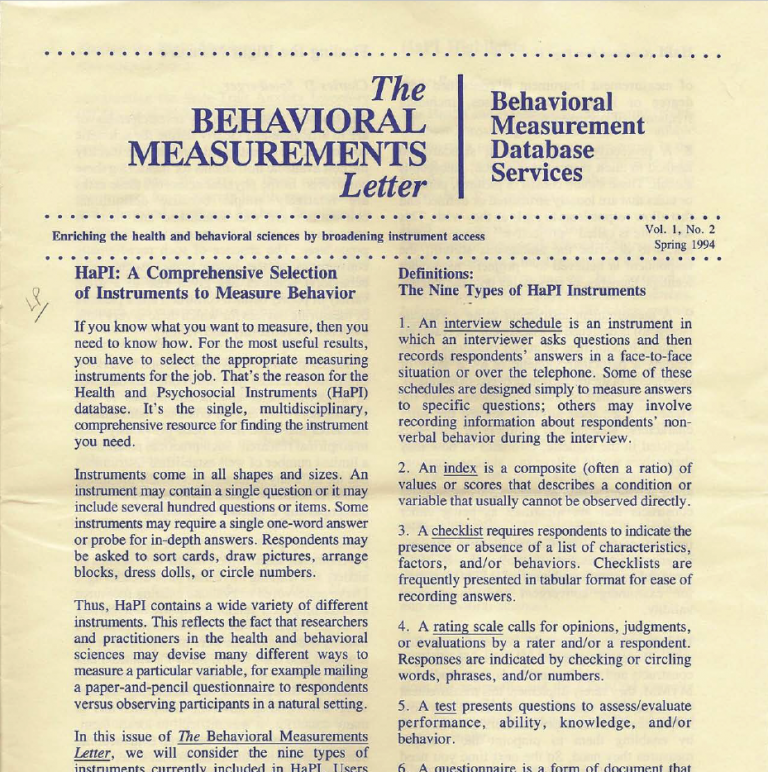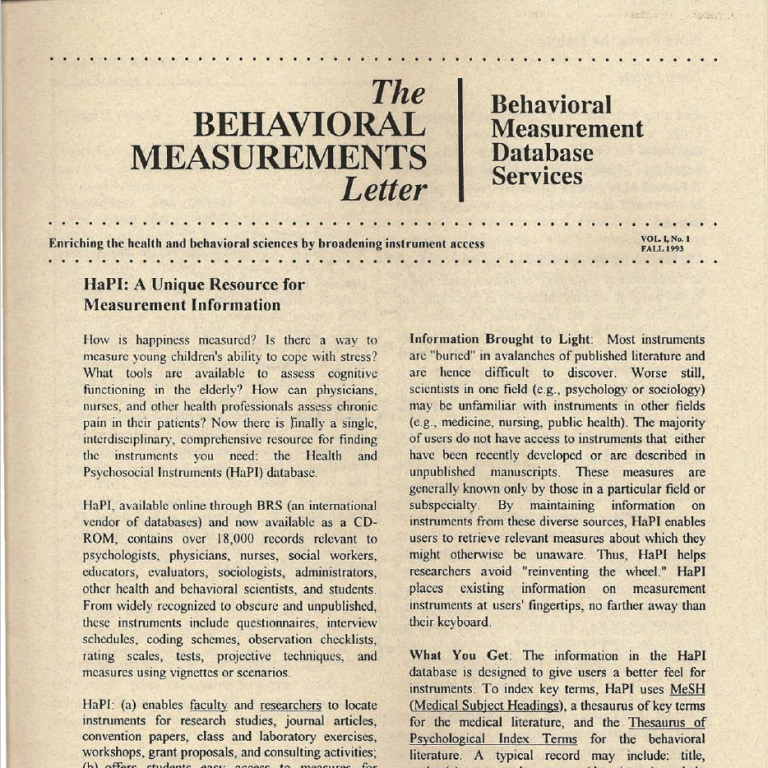Vol. 6, No. 2: Fall 1999
Introduction to This Issue
I begin my introduction to this issue of The Behavioral Measurement Letter with an apology to both its readers and contributors. This issue is very much behind schedule due mostly to me, more specifically, a series of illnesses I suffered and the resultant accumulating backlog of various items of business, The BML included. I want to thank all of you for your patience and understanding, and especially our regular contributor, Fred Bryant, for his expert assistance in editing this issue.
One of the most interesting yet least investigated topics at the intersection of health care and social science is the relationship of spirituality to health and illness. In this issue, Bruce Frey and Timothy Daaleman discuss their current work to define and measure the construct spirituality. Their review of prior work found that existing studies of spirituality in health have two fundamental flaws: (a) these studies mostly examine religiosity rather than spirituality, or they otherwise confound these two different constructs, and/or (b) the studies examine spirituality from the perspective of the health care provider or researcher rather than that of the patient/subject in whom the spirituality of interest resides and from whom such is expressed. Given the lack of valid studies and measures of spirituality, Drs. Frey and Daaleman have initiated qualitative studies to define the construct of spirituality so that it then may be operationalized.
Understanding a culture, one’s own or a foreign culture, requires knowledge of how persons in that culture view their world. This, in turn, requires tools to obtain such knowledge. John Gatewood, a cognitive anthropologist, discusses three measurement methods for measuring similarities, differences, and relationships among products of a culture or items in its environment — free listing, pile sorting, and triadic comparison. Using examples from our own culture and environment, he shows how these tools may be used to begin to gain an understanding of a culture. One drawback of using these tools, however, is that data analysis can be cumbersome and time-consuming. Thus, at the end of his column, Dr. Gatewood provides an Internet website address of a manufacturer of data analysis software to be used in processing data obtained by these methods.
Once again, Fred Bryant writes about measurement modeling. In this installment of a continuing series on the topic, he discusses the use of measurement modeling to determine if what is measured by the Affect Intensity Measure (AIM) is one construct or more than one construct, that is, if the AIM taps one factor or multiple factors. The work Dr. Bryant reports indicates that the AIM actually measures three factors, and that the construct “affect intensity,” as measured by the AIM, therefore consists of three factors. As in preceding columns in the series, this piece clearly demonstrates how measurement modeling is useful in defining the “structure” of a measurement instrument and thereby contributes to our understanding of instruments and of constructs as operationalized by instruments.
Address comments and suggestions to The Editor, The Behavioral Measurement Letter, Behavioral Measurement Database Services, PO Box 110287, Pittsburgh, PA 15232-0787. If warranted and as space permits, your communication may appear as a letter to the editor. Whether published or not, your feedback will be attended to and appreciated.
We also accept short manuscripts for The BML. Submit, at any time, a brief article, opinion piece or book review on a BML-relevant topic to The Editor at the above address. Each submission will be given careful consideration for possible publication.
HaPI reading..
Al K. DeRoy, Editor
Toward a Patient-Centered Measure of Spirituality
Bruce B. Frey and Timothy P. Daaleman
Spirituality has become an accepted, even fashionable part of the contemporary American social scene. It should come as little surprise, then, that spirituality has an increasingly larger presence in health care, as evidenced by recent discussions of this ill-defined construct in both clinical and research settings (Levin, Lavson, & Puchalski, 1997). However, development of operational and clinically useful definitions, a classification scheme, and methods to assess spirituality in health care contexts remain in their infancy (Daaleman, 1999).
Most research on relationships of spirituality to health and well-being has concentrated on “religiosity” or religion-based constructs, rather than the broader construct, “spirituality.” Within this limited context of “religiosity,” researchers from the fields of psychology, sociology and, to a lesser extent, theology and pastoral care have produced some measures and templates for instrument development. The relatively few studies of spirituality in health and illness have been compromised by the lack of precision and clarity in operationally defining “spirituality” (Sloan, Bagiella, & Powell, 1999).
In response to this need for a clear, precise definition of spirituality in health care, two recent national conferences — one sponsored jointly by the National Institute on Aging (NIA) and the Fetzer Institute (Ory & Lipman, 1998), the other by the National Institute for Healthcare Research (NIHR) (Larson, Swyers, & McCullough, 1998) — focused on challenges in defining and measuring religiousness and spirituality. Products of these conferences have provided investigators some direction and guidelines for researching spirituality within health care settings.
Although the fields of theology and pastoral care have long examined spirituality and religion, there has been little empiric testing or validation of instruments used in these disciplines. Nonetheless, these faith-based sources can provide ample materials and resources for developing instruments to measure spirituality as well as religiosity. One such resource is Measures of Religiosity, a text edited by Peter Hill and Ralph Hood, to be published by Religious Education Press.
In choosing or developing an appropriate scale, researchers must first examine their overall project goals and objectives to determine which spiritual dimension (i.e. practice or belief system) is most applicable. For example, studies of chronic illness would benefit from scales that emphasize spiritual coping or support (practice), while projects that focus on health-related behaviors would benefit from a measure of belief systems. In any case, there are, at present, no parsimonious yet comprehensive scales that are applicable in all research settings. What follows is a brief overview highlighting some of the pitfalls and challenges in producing an operational definition of spirituality, a necessary step in developing an instrument to measure spirituality in health and illness.
Our review of previous work revealed the primacy of investigator-based constructs of spirituality and the virtual exclusion of the patient’s perspective. However, much of the current interest in the spiritual aspects of health care stems from two highly patient-centered movements within medicine: end-of-life care and alternative medicine. Given these movements toward patient-centered and relationship-centered care, and given the reasonable assumption that the agent for any spirituality-related outcome substantially resides in the patient, we chose to begin with a patient-centered approach. Use of a patient-centered approach will permit us to define the presently ill-defined construct of health-related spirituality from the perspective of patients.
Measurement theory and practice provide quantitative methods for illuminating constructs and exploring validity arguments linked to hypothesized definitions of constructs. By its nature, the process requires that scores be obtained for some group on a set of items or tasks, and then the scores examined, correlated or compared in order to shed light on the nature or components of the construct of interest. The validity of those scores is a grand summary of all existing evidence for meaningful interpretation of the scores and the potential consequences of those interpretations (Messick, 1989). Strictly speaking, it refers to the meaningfulness of scores, not the value of the constructs employed in developing the items used to obtain the scores. But clearly, the meaningfulness of item responses is dependent on the extent to which the dimension to be measured has been appropriately well-defined (Foddy, 1993).
In order to develop quantitative measures, it is necessary to create operational definitions of the constructs to be measured, a task that is best begun using qualitative methods. Qualitative tools, such as directed interviews, open-ended questionnaires and focus groups, can generate both ideas and understanding. Also, in developing instruments, we are mindful that the definition of a construct is meaningful to the extent that it authentically captures subjects’ understanding of the construct. Thus, we have begun to develop patient-centered measures of spirituality and its relationships to health and well-being using qualitative techniques.
One qualitative research tool we have chosen to use is focus groups. Methodological descriptions of focus groups are beyond the scope of this discussion and are presented elsewhere (for example, Maxwell, 1996; Strauss & Corbin, 1998). The operational definition of “focus group” that we employ is “a small group of people with specific, targeted characteristics who are asked a series of directed questions in a forum designed to promote a contextual understanding.” Focus groups are a type of purposeful sampling where members are selected because of a specific attribute. The researcher does not, at least at this stage of the instrument development process, wish to generalize to a larger population, but through an analysis of the transcribed focus group sessions, seeks to identify and understand the themes generated by the groups in response to the directed questions. Size considerations are not based on issues of statistical power, but rather on saturation which seeks a total sample size that provides differing perspectives until no new themes emerge from the sessions.
The focus groups that we formed were recruited within a university medical center. In order to define spirituality in the contexts of both illness and wellness, one set consisted of patients with an identified medical condition (type 2 diabetes mellitus), a second, independent set of focus groups consisted of persons with no self-identified acute or chronic illness. Some core questions that we used to frame the discussion include, “When you hear the word ‘well-being,’ what comes to mind? How would you define it?” Then, to explore the link between subjective well-being and spirituality, the following was posed to the groups: “There has been a lot of talk about spirituality recently. What is spirituality? What is the connection between spirituality and your understanding of well-being?”
Transcripts of the sessions are then coded for analysis, the goal being to reflect accurately the output or “common voice” of the focus group. We have been using the coding methods suggested by Strauss and Corbin (1998) in order to generate categories, dimensions and theoretical relationships. In the coding process, the transcripts are reviewed sentence by sentence, phrase by phrase, sometimes even word by word, and the thoughts expressed are categorized (i.e., coded). Once compiled, the list of categories — often quite long is then reanalyzed and edited to combine, refine, and reduce the number of categories, often with input from collaborators or expert reviewers who provide additional interpretative perspectives. The process is complete when consensus is reached among the investigators that further analysis will add very little or nothing of value. Points of theoretical connection among categories, or nodes, are then identified, expanded or merged, and preliminary models may emerge.
Once we produce a patient-centered conceptual definition of spirituality via the methods described above, we will move into the second stage, i.e., creating items for a quantitative scale to measure health-related spirituality. Next the items will be piloted and then revised with reference to theory as well as psychometrics.
If spirituality is an aspect of human nature that affects well-being, it is vital that the definition one chooses for it reflects the views of those affected. To date, however, measures of spirituality within health care settings have been developed from the investigator’s perspective exclusively, yet its effect on patients is what is of interest. Measures generated from a patient- centered model, as we have outlined, could authentically capture spirituality in health and illness.
References
Daaleman, T.P. (1999). Science of the spirit. How researchers quantify the value of belief. The Park Ridge Center Bulletin, 7, 13-14.
Ferris, L.E., & Tudiver, F. (1992). Creating an original measure. In Stewart, M.A. et al. (Eds). Tools for Primary Care Research. Newbury Park, CA: Sage.
Foddy, W. (1993). Constructing questions for interviews and questionnaires. Cambridge, UK: Cambridge University Press.
Larson, D.B. Swyers, J.P., & McCullough, M.E. (Eds). (1998). Scientific research on spirituality and health: a consensus report. National Institute for Healthcare Research, Rockville, MD.
Levin, J.S., Larson, D.B., & Puchalski, C.M. (1997). Religion and spirituality in medicine: Research and education. Journal of the American Medical Association, 278, 792-793.
Maxwell, J.A. (1996). Qualitative research design: An interpretive approach. Thousand Oaks, CA: Sage.
Messick, S. (1989). Validity. In R.L. Linn (Ed.). Educational measurement. New York: American Council on Education.
Ory, M., & Lipman, P.D. (1998) Religion and spirituality in aging and health. National Institute on Aging, Behavioral and Social Research Program, Bethesda, MD.
Sloan, R.P., Bagiella, E., & Powell T. (1999). Religion, spirituality, and medicine. Lancet, 353, 664-667.
Strauss, A., & Corbin, A. (1998). Basics of qualitative research: Techniques and procedures for developing grounded theory. (2nd ed.) Thousand Oaks, CA: Sage.
Bruce Frey is an Assistant Professor at the University of Kansas, School of Education, Department of Psychology and Research in Education, where he teaches courses in measurement, research design, and statistics. His research interests include applied measurement, survey construction, and program evaluation. His work in the past has included risk and resiliency factors in predicting drug abuse, and physician’s attitudes towards religion.
Timothy P. Daaleman, DO, is an Assistant Professor in the Departments of Family Medicine and the History and Philosophy of Medicine at the University of Kansas Medical Center School of Medicine. He also holds an appointment as Assistant Scientist at the University of Kansas Center on Health in Aging, and is a Robert Wood Johnson Foundation Generalist Faculty Scholar.
Read additional articles from this newsletter:
6-2-fall-1999

